News
thumbnail
Security
Telefónica and IBM team up for quantum-safe servicesTelefónica and IBM team up for quantum-safe services
Telefónica Tech and IBM have signed a deal to develop security tech to combat threats posed by future ‘cryptographically relevant’ quantum computers.
Subscribe and receive the latest news from the industry.
Join 56,000+ members. Yes it's completely free.








































.png?width=300&auto=webp&quality=80&disable=upscale)


_1.jpg?width=300&auto=webp&quality=80&disable=upscale)